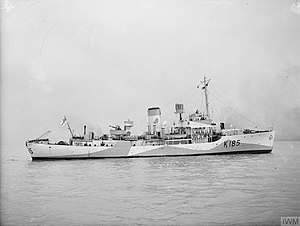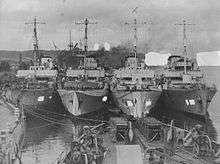HMS Alisma (K185)
HMS Alisma was a Flower-class corvette that served in the Royal Navy.
 | |
| History | |
|---|---|
| Name: | HMS Alisma |
| Builder: | Harland and Wolff, Belfast |
| Laid down: | 19 Aug 1940 |
| Launched: | 17 Dec 1940 |
| Completed: | 13 Feb 1941 |
| Commissioned: | 15 Feb 1941 |
| Decommissioned: | 11 Jun 1945 |
| Identification: | Pennant number: K185 |
| Fate: | Sold 1947. Sunk 1954. |
| General characteristics | |
| Class and type: | Flower-class corvette |
| Displacement: | 925 long tons |
| Length: | 205 ft (62 m) o/a |
| Beam: | 33 ft (10 m) |
| Draught: | 11 ft 6 in (3.51 m) |
| Propulsion: |
|
| Speed: | 16 kn (30 km/h) |
| Range: | 3,500 nmi (6,500 km) at 12 kn (22 km/h) |
| Complement: | 85 |
| Sensors and processing systems: |
|
| Armament: |
|
| Service record | |
| Commanders: |
|
| Operations: | |
Background
At the outbreak of World War II the Marine nationale (French Navy) needed ships for anti-submarine warfare (ASW) and, following the Royal Navy's example, placed orders from Smith’s Dock in South Bank, Middlesbrough, for four ASW corvettes. Following this the Marine nationale ordered a further 18 ships, to be built at a number of British and French shipyards; 6 were built by Harland and Wolff in Belfast. The Fall of France in June 1940 brought a drastic change to these building programmes. Of the second order, the 12 ships under construction in Britain were taken over by the RN and re-armed with British ordnance; all of these French corvettes were renamed and given 'Flower' names in keeping with the class.[1][2]
HMS Alisma (and HMS Burdock) wore a yellow and blue pattern of ship camouflage in the Atlantic. The colour faded quickly in service, becoming a yellow-tinged, off-white colour.[3][4]
Officers and crew
During her service with the Royal Navy she was commanded by Acting Lieutenant Commander Maurice George Rose, RANVR from 2 May 1941 to 1 May 1943.[5] He was succeeded by Lieutenant George Lanning, RANVR until 11 June 1945. The RANVR was a volunteer reserve force of the Royal Australian Navy.
Rose, as a Lieutenant, joined HMS Erica building at Harland and Wolff in Belfast. The ship was commissioned in August 1940. Promotion to Acting Lieutenant Commander with seniority from 4 October 1940 aroused in the 38 year old thoughts of his own command. Rose wrote to the Admiralty informing them that he would like promotion, not to a trawler, but a new corvette from Harland and Wolff with all his officers to be Australian Reservists; he also requested that his anti-submarine ratings be Australians. The specific request for a Harland and Wolff ship had come after a study of vessels from various yards convinced him of the superiority of that company’s craft. My Lords of the Admiralty, surprisingly, had granted his request when Rose commissioned HMS Alisma on 14 February 1941.[6]
Service history
Battle of the Atlantic
In 1941 Western Approached Command had formed 8 escort groups.[7] The 1st Escort Group consisted of six destroyers and four Flower-class corvettes.[8] They were soon in action with other groups between 19 July – 1 August 1941 with Convoy ON 69 defending 26 merchant ships from 8 U-boats and 2 Italian submarines.

In February and March 1942 the original eight escort groups were reorganized into the Mid-Ocean Escort Force (MOEF). Alisma was part of Escort Group B7, one of seven such British naval groups which served with the Mid-Ocean Escort Force (MOEF). It provided convoy protection in the most dangerous midsection of the North Atlantic route.[9] B7's first convoys, in the spring of 1942, were uneventful, and as the pace of the Battle of the Atlantic hotted up in the summer and autumn, the group's charges were escorted without loss. But in December, while escorting ON 153, the convoy came under attack, and three ships were sunk. During this action, on 11 December, Firedrake was torpedoed by the U-boat U-211 and sank with the loss of 168 of her crew, including her current commander, and the group's Senior Officer – Escort (SOE), Commander Eric Tilden. Initially 35 survived the torpedoing, but only 27 managed to get on board Sunflower, which was under the command of Lieut- Commander John Treasure Jones.[10]
B7 was involved in the battles for convoys ONS 20 and ON 206, ON 207 and ON 208, during which period nine U-boats were destroyed.
Battle of the Mediterranean
From autumn 1943 until April 1945 Alisma was deployed in the Mediterranean escorting KMS and MKS convoys. The KMS series of mercantile convoy sailed from the UK to Gibraltar and onward into the Mediterranean from October 1942. The MKS series of convoy replaced the earlier HG series and ran from the Mediterranean to the UK via Gibraltar. The new series was introduced after Operation Torch in October 1942 and operated until May 1945.[11]
She then returned to the North Atlantic until the end of the war, escorting convoys between Liverpool and New York.
Fate
Alisma was decommissioned on 11 June 1945. She was sold in 1947 and became the merchant ship SS Laconia in 1949.[12] Purchased by K. Samartzopoulos of Piraeus in 1950 and renamed SS Constantinos S and then by D. Efthimiou of Piraeus in 1952 and renamed SS Parnon. She sunk as a result of water leakage (flooding) on 16 July 1954.[13]
References
- Elliott 1977, p. 188.
- From Harland and Wolff: HMS Abelia (K184), HMS Alisma (K185), HMS Anchusa (K186), HMS Armeria (K187), HMS Aster (K188) & HMS Bergamot (K189)
- "Ships Camouflage data".
- "Colour image of camouflage design".
- Helgason, Guðmundur. "Warship Commanders". Uboat.net. Retrieved 30 September 2019.
- "HMAS Diamantina, page 12".
- Elliott 1977, p. 59.
- HMS Alisma (K185), HMS Dianella (K07), HMS Kingcup (K33) & HMS Sunflower (K41)
- Helgason, Guðmundur. "HMS Alisma (K 185)". Uboat.net. Retrieved 28 September 2019.
- Tramp to Queen pp. 69–79
- "HMS Alisma on the Arnold Hague database at convoyweb.org.uk".
- operated by Cia Maritima Mensabe SA, Panama City.
- "Wreck site database".
Sources
- McCluskie, Tom (2013). The Rise and Fall of Harland and Wolff. The History Press. ISBN 9780752488615.
- Elliott, Peter (1977). Allied Escort Ships of World War II. ISBN 0-356-08401-9.CS1 maint: ref=harv (link)
- Donaldson, Graham. "Royal Australian Naval Volunteer Reserve". The World at War.
- Nunan, Peter (2005). HMAS Diamantina: Australia’s last river class frigate, 1945-1980. Slouch Hat Publications. ISBN 978-0957975279.
- Treasure Jones, John (2008). Tramp to Queen. The History Press. ISBN 978-0-7524-4625-7.